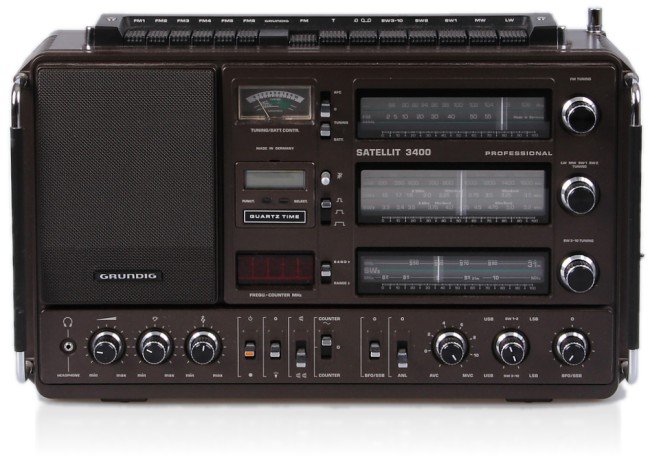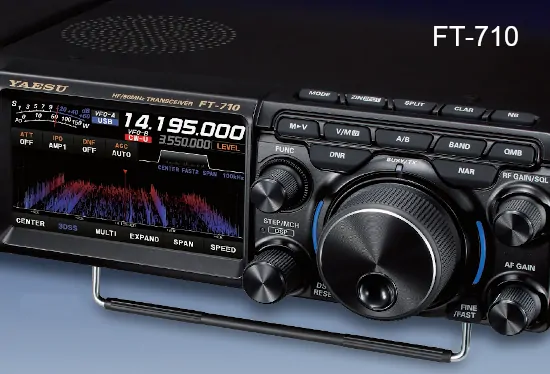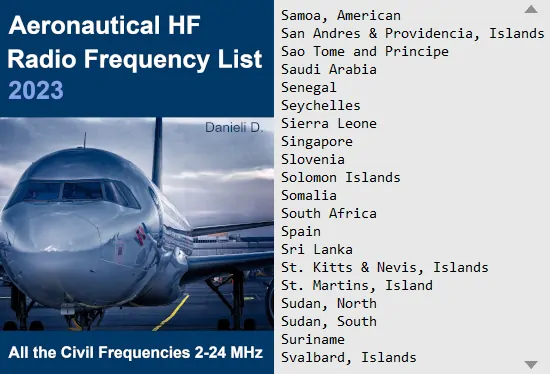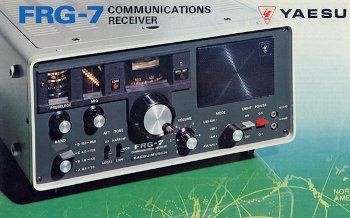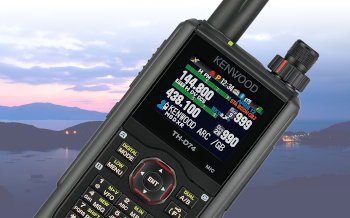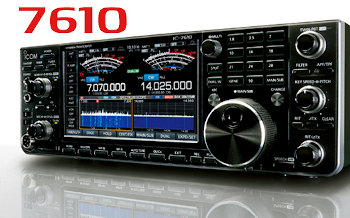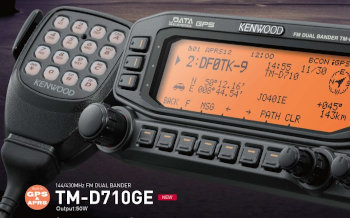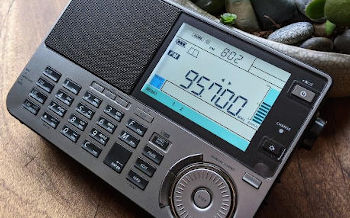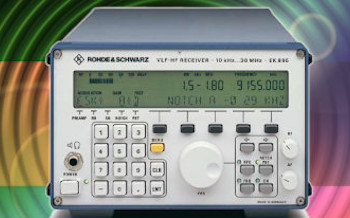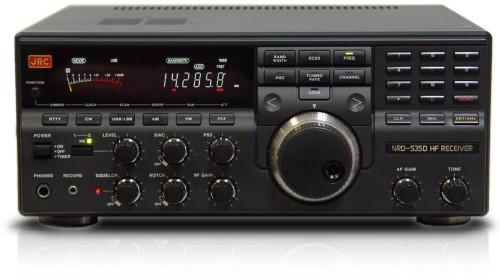
Triple-conversion HF desktop receiver. Analogical configuration, frequency range 0.1-30 MHz all-mode. With IF notch filter, sync-AM, pass-band tuning (PBT). Ideated in Japan.
Reference market : amateur-radio
NRD-535 specifications
| General |
| Frequency coverage | |
|---|---|
| 0.1000 ~ 30.0000 MHz | |
| Mode | |
| CW / RTTY / LSB / USB / AM / AM-S / FM | |
| Tuning step | |
| 1 / 10 / 100 Hz
1 MHz |
| Receiver |
| Sensitivity | |
|---|---|
| SSB / CW | 5.0 uV (0.1~0.5 MHz, 10dB S/N)
2.0 uV (0.5~1.6 MHz, 10dB S/N) 0.32 uV (1.6~30 MHz, 10dB S/N) |
| RTTY | 5.0 uV (0.1~0.5 MHz, 10dB S/N)
2.0 uV (0.5~1.6 MHz, 10dB S/N) 0.32 uV (1.6~30 MHz, 10dB S/N) |
| AM | 16.0 uV (0.1~0.5 MHz, 10dB S/N)
6.3 uV (0.5~1.6 MHz, 10dB S/N) 2.0 uV (1.6~30 MHz, 10dB S/N) |
| FM | 0.5 uV (1.6~30 MHz, 12dB SINAD) |
| Selectivity | |
| SSB | > 2.0 KHz (-6dB)
< 6.0 KHz (-60dB) |
| CW / RTTY | > 1.0 KHz (-6dB)
< 3.0 KHz (-60dB) |
| AM / AM-S | > 6.0 KHz (-6dB)
< 15 KHz (-60dB) |
| FM | > 12 KHz (-6dB) |
| IF filter ultimate attenuation [1] | |
| 70 dB | |
| RF attenuator | |
| 20 dB | |
| DR (Dynamic Range) [1] | |
| 92 dB (50 KHz spaced signals)
70 dB (5 KHz spaced signals) |
|
| Blocking [1] | |
| 114 dB (100 KHz spaced signal) | |
| IP3 (3rd order intercept point) | |
| +20 dBm (14 MHz) | |
| Image rejection | |
| > 70dB | |
| IF rejection | |
| > 70dB | |
| PBT (Passband Tuning) | |
| ±1 KHz | |
| Notch filter | |
| > 40 dB | |
| NB (Noise Blanker) | |
| Level adjustable | |
| AGC (Automatic Gain Control) | |
| Fast, slow, OFF | |
| Frequency stability | |
| ± 10ppm max within 5~60' warm-up
± 2ppm/h max at steady temperature ± 0.5ppm max with temperature from -20°C to +50°C [2] |
|
| IF (Intermediate Frequency) | |
| 1° | 70.455 MHz |
| 2° | 455.0 KHz |
| 3° | 79.0 KHz (not for FM) |
| Features |
| Memory | |
|---|---|
| 200 regular memories
2 for programmed scan limits |
|
| Display | |
| 10 Hz frequency resolution
40-segments signal meter bar |
|
| Antenna | |
| SO239 50Ω
Terminal jack 600Ω (0.1~1.6 MHz) |
|
| Power supply | |
| 12 ~ 16 VDC external, 13.8V nominal
100~240 VAC |
|
| Power consumption | |
| 25 W | |
| Audio power | |
| 1 W on 4Ω | |
| Audio output | |
| Jack 6.35 mm headphone
Jack 3.5 mm line Jack external speaker |
|
| Connections | |
| RS232C-9 PC
Plug timer Plug mute Plug 10.8VDC |
| Mechanical and environmental data |
| Dimensions | |
|---|---|
| 300 (W) x 130 (H) x 324 (D) mm | |
| Weight | |
| 9kg |
- This parameter, not in official data, was obtained with direct tests.
- With CGD-135 optional unit.

Updated | Complete | UK - NORTHERN IRELAND
378 pages | 300+ Airports and Airfields
Voice com. | ACC | FIC | VOLMET | ACARS | VDL | ILS | VOR | DME
The JRC NRD-535 has been marketed in two variants, the base that is associated with this identification and the advanced one that takes the name of JRC NRD-535D. In the last one there are already those that would otherwise be options, it is the CMF-78 module for the AM-S, the CFL-243 module for the PBT, and the CFL-233 filter. The apparatus adopts a triple frequency conversion configuration and covers the 0.1~30 MHz range in all operating modes with a minimum tuning step equal to 1 Hz. To achieve adequate dynamics the front end adopts a first stage preamplifier equipped with a parallel of four FETs for an overall IP3 of +20 dBm, this stage is preceded by a bank of six tunable band-pass RF preselection filters. The latter cover the segments of 0.1~0.4 / 0.4~1.6 / 1.6~4.4 / 4.4~12.3 / 12.3~20.5 / 20.5~30 MHz, each consisting of a double resonant circuit regulated by varicap diodes.
The receiver has a rational set of commands on the front panel, it is really easy to manage while integrating a considerable number of functions. Among these: AM demodulation even of synchronous type (ECSS, Exalted Carrier Selectable Sideband), PBS pass-band-shift to move the IF window of ±1 KHz and the PBT pass-band-tuning to continuously narrow the IF window between 0.5~2.4 KHz (NRD-535D), double noise-blanker differentiated for times with intervention level adjustment, notch filter on IF, AGC time constant selectable between two values or also disactivated, continuous regulation of gain in the IF, squelch, RF attenuator, audio tone control, on-off timer, timer output connection to activate a recorder, mute connection for pairing to a transceiver. The tuning setting can be performed by rotary control, with direct input from the keyboard, or even remote PC management. The large display shows all status information including the S-meter which emulate the line of an analog instrument with segments. There are 200 memory locations to associate frequency, mode, the AGC constant, the RF attenuator and the IF filter. Search options between channels in memory, with a speed that can be set between 0.5~5 channels/second, and between frequency limits, with a speed that can be set between 0.05~0.5 steps/second.
NRD-535 IF filters :
Inside the radio there are four positions for the installation of filters at the level of the 2nd IF. The NRD-535 model is equipped with two standard filters, corresponding to the wide and intermediate positions, while the NRD-535D model has three of the series adding the narrow position. There is therefore space for one or two optional filters, the characteristics of the components made available by the manufacturer are as shown in the following table.
| Filter CFL-231 / Specifications | |
|---|---|
| Mode | CW |
| IF | 455 KHz |
| Bandwidth | 0.3 KHz (-6dB) |
| Filter CFL-232 / Specifications | |
| Mode | CW |
| IF | 455 KHz |
| Bandwidth | 0.5 KHz (-6dB) |
| Filter CFL-233 (installed on the NRD535D) / Specifications | |
| Mode | CW / RTTY |
| IF | 455 KHz |
| Bandwidth | 1.0 KHz (-6dB) |
| Filter CFL-218A / Specifications | |
| Mode | SSB / RTTY |
| IF | 455 KHz |
| Bandwidth | 1.8 KHz (-6dB) |
| Filter CFL-251 / Specifications | |
| Mode | SSB |
| IF | 455 KHz |
| Bandwidth | 2.4 KHz (-6dB) |
It should be noted that with the exception of the FM each filter can be selected for each reception mode. This feature is peculiar because in other brands and models there is no similar freedom of choice, the receiver with this intrinsic flexibility meets the real needs of monitoring on the HF spectrum.
NRD-535 performance and practical notes :
The JRC NRD-535 was the manufacturer's flagship device before the transition, in the amateur radio and BCL circle, from the analog to the digital configuration with the model NRD545 that was the successor of the series. Following the philosophy of the JRC this receiver implements high-level solutions and details borrowed from the production of professional systems, this is mechanically recognizable in the modular construction that uses different plug-in boards connected to a common bus to guarantee robustness and RF shielding. In this respect, the JRC has always been linked to the concept of high quality and the NRD535 does not differ from this profile, after many years from the end of production the receiver keeps for this reason still a considerable value, both technical and economic.
From the strictly practical side, therefore inherent the use by enthusiasts, the evaluation becomes more complex. There are certainly several points in favor, such as the extreme simplicity in managing its functionality thanks to an ergonomically designed front panel, and still a notch filter operating on the 3rd IF of good performance and stability over time (not all the notch filters on IF maintain effectiveness over the years, ed.), The possibility of using synchronous demodulation (ECSS) for AM with selection between LSB/USB, not least a satisfactory dynamic behavior in the presence of strong signals in the band.
Alongside these elements there are others that although not really negative, from the point of view of employment, are anything but ideal. The parameter that is most evident is the selectivity, the wide range of filters allows you to cope with different listening scenarios from each other but by analyzing the nominal values of the individual bandwidths it is noted that a different combination would have been preferable with, for example, a 2.4 KHz filter instead of 2.0 KHz installed as standard - a value that is too narrow for the common need for listening in SSB but at the same time too large for other digital modes. Also the form factor of the filters is good but not excellent, at least compared to the analogue indexes of the competitor receivers of the period, with the exception of the AM where the attenuation values at 6/60 dB are in line with the expectations. Overall, therefore, a class receiver for quality but that the enthusiast must know in the minute aspects to get the maximum profit.
NRD-535 price
We have collected for your convenience the JRC NRD535 sale price (Euro) and its trend over time. Useful to guarantee a cheaper purchase of this radio and to put it for sale in the second-hand market. Of course offers, accessories, warranty terms and conditions can lead to different figures.
|
|
|
|
|
EUR 813.00 (699GBP) |
2021-oct |
Second Hand In good condition |
|
EUR 1225.00 (1437USD) |
2018-nov |
Second Hand Great condition overall |
NRD-535 review
| Sensitivity | |
| Selectivity | |
| Dynamic range | |
| Spurious response | |
| Audio | |
| Signal functions | |
| Control functions | |
| User friendly | |
| Stars: 1=insufficient | 2=just sufficient | 3=mediocre | 4=good | 5=excellent | |
Your opinion on merits, defects, experiences, with this radio set is welcome. Write your review, after a technical evaluation by our staff if found suitable will be published on this page. We thank you for your precious contribution.
